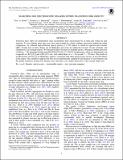Files in this item
Searching for spectroscopic binaries within transition disk objects
Item metadata
| dc.contributor.author | Kohn, Saul A. | |
| dc.contributor.author | Shkolnik, Evgenya L. | |
| dc.contributor.author | Weinberger, Alycia J. | |
| dc.contributor.author | Carlberg, Joleen K. | |
| dc.contributor.author | Llama, Joe | |
| dc.date.accessioned | 2016-03-30T11:30:13Z | |
| dc.date.available | 2016-03-30T11:30:13Z | |
| dc.date.issued | 2016-03-10 | |
| dc.identifier | 241226297 | |
| dc.identifier | 46ef86c3-5d15-44db-b39b-0701dbb9d6ee | |
| dc.identifier | 84962282061 | |
| dc.identifier | 000372787000002 | |
| dc.identifier.citation | Kohn , S A , Shkolnik , E L , Weinberger , A J , Carlberg , J K & Llama , J 2016 , ' Searching for spectroscopic binaries within transition disk objects ' , Astrophysical Journal , vol. 820 , no. 1 , pp. 1-15 . https://doi.org/10.3847/0004-637X/820/1/2 | en |
| dc.identifier.issn | 0004-637X | |
| dc.identifier.other | ArXiv: http://arxiv.org/abs/1602.07582v1 | |
| dc.identifier.uri | https://hdl.handle.net/10023/8516 | |
| dc.description | S.A. Kohn acknowledges the support of NSF REU grant AST-1004107 through Northern Arizona University and Lowell Observatory. J. Llama acknowledges support from NASA Origins of the Solar System grant No. NNX13AH79G and from STFC grant ST/M001296/1. This research made use of the SIMBAD database, operated at CDS, Strasbourg, France. | en |
| dc.description.abstract | Transition disks (TDs) are intermediate stage circumstellar disks characterized by an inner gap within the disk structure. To test whether these gaps may have been formed by closely orbiting, previously undetected stellar companions, we collected high-resolution optical spectra of 31 TD objects to search for spectroscopic binaries (SBs). Twenty-four of these objects are in Ophiuchus and seven are within the Coronet, Corona Australis, and Chameleon I star-forming regions. We measured radial velocities for multiple epochs, obtaining a median precision of 400 ms−1. We identified double-lined SB SSTc2d J163154.7–250324 in Ophiuchus, which we determined to be composed of a K7(±0.5) and a K9(±0.5) star, with orbital limits of a < 0.6 au and P < 150 days. This results in an SB fraction of in Ophiuchus, which is consistent with other spectroscopic surveys of non-TD objects in the region. This similarity suggests that TDs are not preferentially sculpted by the presence of close binaries and that planet formation around close binaries may take place over similar timescales to that around single stars. | |
| dc.format.extent | 15 | |
| dc.format.extent | 2159714 | |
| dc.language.iso | eng | |
| dc.relation.ispartof | Astrophysical Journal | en |
| dc.subject | Binaries | en |
| dc.subject | Spectroscopic | en |
| dc.subject | Circumstellar matter | en |
| dc.subject | Stars: pre-main sequence | en |
| dc.subject | QB Astronomy | en |
| dc.subject | QC Physics | en |
| dc.subject | NDAS | en |
| dc.subject.lcc | QB | en |
| dc.subject.lcc | QC | en |
| dc.title | Searching for spectroscopic binaries within transition disk objects | en |
| dc.type | Journal article | en |
| dc.contributor.sponsor | Science & Technology Facilities Council | en |
| dc.contributor.institution | University of St Andrews. School of Physics and Astronomy | en |
| dc.identifier.doi | https://doi.org/10.3847/0004-637X/820/1/2 | |
| dc.description.status | Peer reviewed | en |
| dc.identifier.url | http://arxiv.org/abs/1602.07582 | en |
| dc.identifier.grantnumber | ST/M001296/1 | en |
This item appears in the following Collection(s)
Items in the St Andrews Research Repository are protected by copyright, with all rights reserved, unless otherwise indicated.

